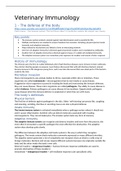Resumen
Immunology, ADP20306 summary
- Grado
- Institución
- Book
A summary of all chapters from veterinary immunology, I.R. Tizard, needed for the course ADP20306. helpful video links are included and key items from each chapter are typed out. chapters (9th ed): 2, 3, 4, 5, 6, 7, 8, 9, 10, 11, 13, 14, 15, 16, 17, 18, 20, 21, 22, 23, 24, 28, 29, 30, 31 and 41.
[Mostrar más]




